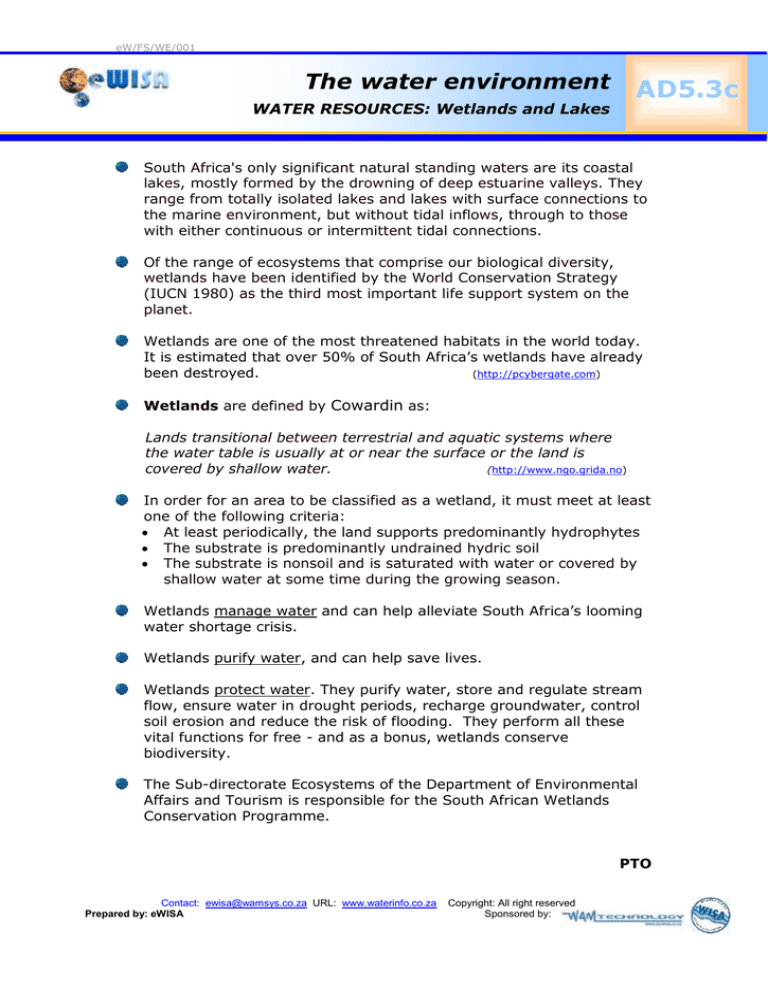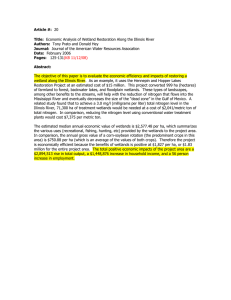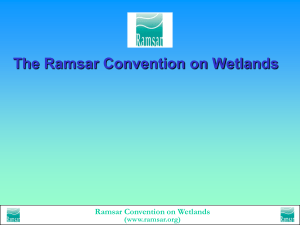
eW/FS/WE/001
The water environment
AD5.3c
WATER RESOURCES: Wetlands and Lakes
South Africa's only significant natural standing waters are its coastal
lakes, mostly formed by the drowning of deep estuarine valleys. They
range from totally isolated lakes and lakes with surface connections to
the marine environment, but without tidal inflows, through to those
with either continuous or intermittent tidal connections.
Of the range of ecosystems that comprise our biological diversity,
wetlands have been identified by the World Conservation Strategy
(IUCN 1980) as the third most important life support system on the
planet.
Wetlands are one of the most threatened habitats in the world today.
It is estimated that over 50% of South Africa’s wetlands have already
been destroyed.
(http://pcybergate.com)
Wetlands are defined by Cowardin as:
Lands transitional between terrestrial and aquatic systems where
the water table is usually at or near the surface or the land is
covered by shallow water.
(http://www.ngo.grida.no)
In order for an area to be classified as a wetland, it must meet at least
one of the following criteria:
At least periodically, the land supports predominantly hydrophytes
The substrate is predominantly undrained hydric soil
The substrate is nonsoil and is saturated with water or covered by
shallow water at some time during the growing season.
Wetlands manage water and can help alleviate South Africa’s looming
water shortage crisis.
Wetlands purify water, and can help save lives.
Wetlands protect water. They purify water, store and regulate stream
flow, ensure water in drought periods, recharge groundwater, control
soil erosion and reduce the risk of flooding. They perform all these
vital functions for free - and as a bonus, wetlands conserve
biodiversity.
The Sub-directorate Ecosystems of the Department of Environmental
Affairs and Tourism is responsible for the South African Wetlands
Conservation Programme.
PTO
Contact: ewisa@wamsys.co.za URL: www.waterinfo.co.za
Prepared by: eWISA
Copyright: All right reserved
Sponsored by:
The Convention on Wetlands of International Importance especially as
Waterfowl Habitat - commonly referred to as the Ramsar Convention
from its place of adoption in Iran in 1971 - was the first of the modern
global intergovernmental treaties on conservation and wise use of
natural resources. The Ramsar mission is:
The conservation and wise use of wetlands by national action and
international cooperation as a means
development throughout the world".
to
achieving
sustainable
There are currently 16 Ramsar sites is South Africa:
Nylsvley Nature Reserve
Blesbokspruit
Barberspan
Seekoeivlei
Natal Drakensberg Park
Ndumo Game Reserve
Kosi Bay System
Lake Sibaya
Turtle Beaches and Coral Reefs
St Lucia System
Wilderness Lakes
De Hoop Vlei
De Mond State Forest
Langebaan
Verlorenvlei
Orange River Mouth Wetland
Contact: ewisa@wamsys.co.za URL: www.waterinfo.co.za
Prepared by: eWISA
Copyright: All right reserved
Sponsored by:





